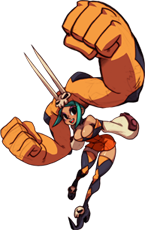Hey there, it’s me again… Peter Bartholow.
Last time I posted, I recounted the Legend of Yamane. This time, I’m going to talk about… community management?
In addition to doing some UI design, implementation and production on Skullgirls and leading design on our next project, I’m currently filling the role you might know at other companies as the dreaded “Community Manager.” It seemed like a natural fit – before becoming a game designer 11 years ago, I was a freelance member of the media in high school and college, writing for a range of publications such as the Dallas Morning News, Gamespot, and GMR.
“Community Manager” might be the most insubstantial-sounding job in the game industry, as well as the most misunderstood. Accordingly, no one at Reverge really predicted how much of my time it would actually take and how important it actually would be as for the game. The job sounds like it’s all Tweeting and posting on Facebook and reading forums, but, at least for me, it has become all that in addition to a writing and production job overseeing everything external to the company. If I had to wear a tie to work, my card might say “Creative Production Director of Public Externalities” or something similarly obtuse-yet-all-encompassing.
Let’s get the first part of it out the way: I am, in fact, the person who posts on forums, Facebook and Twitter, but it takes up the least amount of time of all of my duties. If you’ve talked to a Skullgirls rep through any of those mediums, it’s probably me responding to your comments and questions and relaying your suggestions to the team.
Aside from directly addressing fans, it’s important to keep broadcasting to the rest of the internet to keep the game at the top of peoples’ minds, and tell people where they can find information on the game. With so many games coming out these days, it’s essential we get as much material on the game out there as possible, lest an independent downloadable game like Skullgirls risks getting completely lost in the marketplace. It’s also important to tease new things coming down the line, so people will speculate and keep checking for new information – I try to be clever with this and drop hints into the regular fan content to reward our most loyal fans.
It’s rare to have a Community Manager at such a small studio, and Reverge is lucky that Autumn supports us in that – while of course a fighting game needs good mechanics, it also needs lots of other people playing it, so hopefully my efforts will keep you fighting online for some time to come.
Just reminding people that the game exists isn’t enough – you have to have a reason for them to check up on it, which means generating content. I do this at least three times a week with our regular community features: this blog, Whiteboard Wednesday and Fan Art Friday. While I can’t say I had a master plan when I came up with these weekly features, I now realize that each has a different function: this blog’s purpose is to get people interested in the game by exposing normally-hidden aspects of its development, Whiteboard Wednesday communicates Reverge’s personality and interests so people identify with us as a studio, and Fan Art Friday repackages and reinforces the rest of the community’s fervor for the game. Each week, we’re trying to tie the the game, the studio and the community together in addition to pointing you to any new Skullgirls media or interviews.
Individual-level community outreach is important to solidify casual interest into fandom, but you need mainstream coverage to make them aware of your game in the first place. Outside of generating the community content, I spend the rest of my community time around the material you see posted on gaming sites and blogs.
As the Reverge’s primary contact with Autumn’s marketing and PR, I answer questions, provide assets and wrangle the team for interviews and other public communications. Marketing and PR are insatiable, always wanting new things with which to promote the game – with everyone so busy making Skullgirls, a big part of my job is to get as much of this done as possible without distracting the team. I edit all Skullgirls-related press releases, coordinate team interviews and press meetings and generally strategize with the publisher and PR team as to what we can actually provide them without unduly burdening the game’s development. Around E3 that’s nearly impossible, but the rest of the time I do what I can.
Of course, most of this is done on the internet, meaning you need visuals to help drive it all home. Providing assets like screenshots and videos is surprisingly time-consuming – first the team needs to record replays, and then special builds are used to render the replays out into many gigabytes of TGAs, which then must be compressed and sent off to our video editing contractors. If I’m not capturing the replays and footage myself, I’m working with others to make sure it gets to the right people and represents that game as best as possible given the current state of the game. I’m overseeing the production of our new (and old) character trailers as well as some other new video content, so look forward to more of that in the future.
So that about sums up community management – it’s nearly an endless parade of tasks big and little, dealing with people inside and outside of the company. While I look forward to the day when I can get back to spending more time in my native design role, community management has been more interesting, rewarding and challenging than I ever expected it to be given its questionable reputation.
It’s been great talking to and even meeting our early fans, and I can’t wait until the game is out so the community can really explode.

